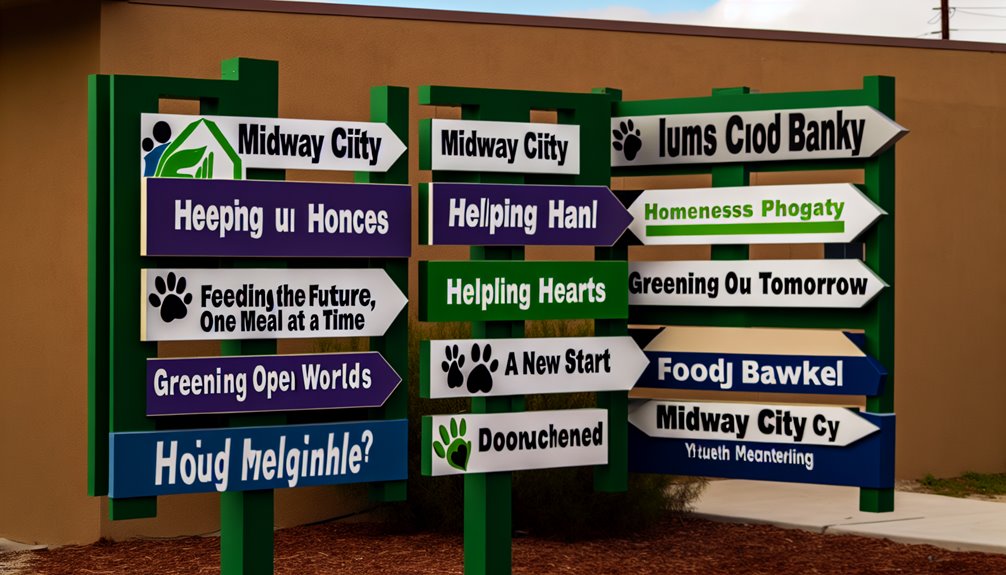In examining the strategic implementation of signage by nonprofit entities in Midway City, it becomes evident that effective signage transcends mere visibility; it plays a crucial role in enhancing community involvement and driving action. By situating signs in high-traffic locations, and utilizing captivating visuals along with persuasive narratives, these organizations can significantly boost their outreach and motivate community participation. The design of these signs is meticulously crafted, taking into account typography, color schemes, and imagery to evoke emotional responses that encourage engagement. Striking a balance between functionality and regulatory compliance is essential for fostering true change. Stay with us as we delve deeper into how these visual instruments are influencing community dynamics.
The Significance of Strategic Signage
Within the realm of nonprofit interaction, employing strategic signage is not merely advantageous; it’s imperative. We have observed that well-designed signs can substantially enhance the aura surrounding our mission, directly affecting our outreach initiatives and fundraising campaigns.
The essence of sign visibility lies not just in being seen but rather in capturing the attention of the right audience at opportune moments. This highlights the importance of effective audience targeting.
A prosperous audience targeting strategy requires an understanding of who our potential supporters are and what drives them to engage with us. Are they local residents passionate about social justice? Or perhaps businesses keen on fulfilling their
delineating these groups enables us to customize our signage so that it resonates profoundly, eliciting strong reactions. Strategically positioning signs in areas frequented by our target demographic increases the chances (e.g., near local shops or community hubs). The objective remains clear: create such an engaging presence that its unachievable to overlook. the use of illuminated channel letters can further amplify this visibility during evening events or in dimly lit areas,ensuring clarity and impact for our messages. The creation of compelling nonprofit signs necessitates more than basic design skills; it demands a profound comprehension of our mission coupled with effective communication strategies. Immersing ourselves fully allows us to focus on two critical components: (1) typography choices (2) color psychology . This goes beyond aesthetics; they serve as strategic tools enhancing both clarity and impact. Selecting appropriate typography significantly influences both readability and tone. Choosing fonts involves balancing visual appeal with practicality—serif fonts may convey tradition while sans-serif options suggest modernity. It’s about selecting typefaces that reflect our values while ensuring accessibility for all audiences. The psychological implications behind colors cannot be overlooked either—they evoke emotions beyond mere decoration. Your commitment ensures each sign isn’t just visible but also impactful—every design decision contributes towards fostering deeper connections within communities. Before embarking on designing nonprofit signs , understanding relevant local , state ,and federal regulations becomes paramount . navigating through legal complexities can prove challenging especially concerning zoning laws & permit requirements . Let’s explore these elements further ensuring compliance throughout every step taken . Zoning regulations dictate where placement occurs along size limitations imposed across diffrent regions within Midway City . Such as residential zones may impose stricter guidelines compared against commercial districts.Understanding nuances here helps avoid potential legal complications arising from non-compliance issues down line. Additionally securing necessary permits shouldn’t be overlooked depending upon size location type involved Midway City might require specific permissions prior installation process commencing .This ensures safety standards upheld preventing obstructions public spaces hazards arising unexpectedly! Close collaboration local authorities clarifying permit requirements confirming adherence applicable laws remains vital throughout this journey! To guarantee both visibility compliance adhering establishedsign conventions< /a >such as size regulations pictogram standards proves essential making sure effectiveness regulatory alignment achieved seamlessly! After navigating through legal intricacies surrounding signage let’s shift focus towards identifyingthat align budgetary constraints without compromising quality! As we delve into this crucial aspect evaluating selection affordable materials alongside strategic placement maximizes exposure impact overall effectiveness! First off choosing suitable materials drastically reduces costs without sacrificing durability options like high-density urethane aluminum composite offer longevity weather resistance fraction conventional material costs incurred previously ! Investing innovative solutions guarantees longevity providing best value investment made over time ! Placement plays significant role cost-effectiveness too well-positioned sign maximizes exposure targeted audience minimizing number needed overall expenditure incurred regarding signage efforts undertaken ! this strategic approach enhances effectiveness reducing total expenses associated creating impactful visuals reaching maximum individuals possible utilizing minimal resources available efficiently ! Crafting Effective Nonprofit Signs
We select hues aligned with desired emotional responses; blue often symbolizes trust while green signifies growth or sustainability.
By thoughtfully curating color palettes, we reinforce how effectively we connect with audiences emotionally through messaging.
To maintain flexibility alongside visibility within designs, digital displays are integrated allowing dynamic content updates promoting enhanced interaction opportunities among viewers!Navigating Legal Aspects for Signage Compliance
A Cost-Conscious Approach To Sign Solutions
Digital Versus Traditional Signs
as we explore various cost-effective alternatives available today considering choice between digital traditional formats becomes imperative weighing benefits each offers against respective drawbacks encountered regularly when implementing either option successfully!
Digital formats provide dynamic content changes superior visibility varying light conditions ability update quickly invaluable urgent communications event-specific messaging however initial investments maintenance costs higher compared conventional counterparts typically utilized nonprofits operating tight budgets !
Conversely traditional styles possess unique charm connecting specific aesthetic resonates many audiences particularly historic conservation-sensitive locales often perceived personable less intrusive fostering familiarity trust amongst viewers alike !
durability lower upfront pricing makes viable alternative nonprofits constrained financially seeking maximize returns investments made wisely over time!
When deciding factors must include upfront ongoing expenses impacts perceptions interactions experienced by targeted demographics ultimately determining success rate achieved via chosen method employed effectively communicating intended messages clearly succinctly throughout duration campaign run successfully achieving desired outcomes consistently delivered upon completion projects undertaken diligently moving forward together collaboratively toward shared goals accomplished collectively united purposefully striving excellence always aiming higher reaching greater heights together hand-in-hand side-by-side supporting one another unconditionally every step way forward onward upward always striving better brighter future awaits ahead filled hope promise possibilities endless opportunities await discovery exploration adventure awaits those willing take leap faith embrace challenges head-on boldly courageously forging paths unknown territories uncharted realms awaiting exploration discovery unveiling mysteries hidden depths waiting reveal secrets long kept guarded closely held tightly bound chains shackles broken free liberated soaring skies limitless horizons beckoning call adventure awaits those brave enough venture forth boldly courageously embracing challenges head-on forging paths unknown territories uncharted realms awaiting exploration discovery unveiling mysteries hidden depths waiting reveal secrets long kept guarded closely held chains shackles broken free liberated soaring skies limitless horizons beckoning call adventure awaits those brave enough venture forth boldly courageously embracing challenges head-on forging paths unknown territories uncharted realms awaiting exploration discovery unveiling mysteries hidden depths waiting reveal secrets long kept guarded closely held chains shackles broken free liberated soaring skies limitless horizons beckoning call adventure awaits those brave enough venture forth boldly courageously embracing challenges head-on forging paths unknown territories uncharted realms awaiting exploration discovery unveiling mysteries hidden depths waiting reveal secrets long kept guarded closely held chains shackles broken free liberated soaring skies limitless horizons beckoning call adventure awaits those brave enough venture forth boldly courageously embracing challenges head-on forging paths unknown territories uncharted realms awaiting exploration discovery unveiling mysteries hidden depths waiting reveal secrets long kept guarded closely held chains shackles broken free liberated soaring skies limitless horizons beckoning call adventure awaits those brave enough venture forth boldly courageously embracing challenges head-on forging paths unknown territories uncharted realms awaiting exploration discovery unveiling mysteries hidden depths waiting reveal secrets long kept guarded tightly bound chains shackle breaking liberate soar sky limit horizon calling adventurers ready embark journey ahead filled hope promise possibility endless chance await discover explore new frontiers push boundaries redefine limits challenge status quo strive greatness achieve dreams aspirations fulfilled live fullest potential unleash creativity innovation ignite passion drive change inspire others lead way pave path future generations thrive flourish succeed together united purposefully striving excellence always aiming higher reaching greater heights together hand-in-hand side-by-side supporting one another unconditional every step way forward onward upward always striving better brighter future ahead filled hope promise possibilities endless opportunities await discover explore new frontiers push boundaries redefine limits challenge status quo strive greatness achieve dreams aspirations fulfilled live fullest potential unleash creativity innovation ignite passion drive change inspire others lead way pave path future generations thrive flourish succeed together united purposefully striving excellence always aiming higher reaching greater heights together hand-in-hand side-by-side supporting one another unconditional every step way forward onward upward always striving better brighter future ahead filled hope promise possibilities endless opportunities await discover explore new frontiers push boundaries redefine limits challenge status quo strive greatness achieve dreams aspirations fulfilled live fullest potential unleash creativity innovation ignite passion drive change inspire others lead way pave path future generations thrive flourish succeed together united purposefully striving excellence always aiming higher reaching greater heights together hand-in-hand side-by-side supporting one another unconditional every step way forward onward upward.





